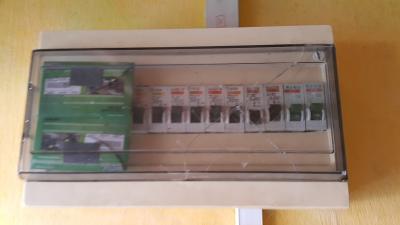QUOTE(stevie8 @ Oct 11 2013, 02:53 PM)
Thanks for the input. You got me, "the only real reason to do what you suggested is to save $ and time inconvenience on hacking and plaster back"
Anyway, hacking is unavoidable for the installation of sub DB where I need to hack out the cable long enough to get all of them one by one into the MCBs in the sub DB. The problem is to hack thru the slab and beam. I do not want another hole thru the beam which is at the middle of the house, it only weaken the beam.
I just need to find two 4mm wires each and twist them together which will support 60A, right? Below is the potential load up-stair:
1 x 2 1/2 hp aircond
2 x 1 hp aircond
1 x iron
5 x fans (not on when use aircond)
30 x downlight, wall light and table lamp.
1 x vacuum cleaner (not use when ironing), my wife cannot be doing 2 things at a time
Many power sockets but seldom use other than mentioned above for ironing, vacuuming, also for charging handphone, hair dryer, no water heater (I use solar heater), TV, Audio, PS2 games.
Therefore, one 4mm for 32A could be enough, but 2 x 4mm definitely more than enough. Then need to connect 2 x 4mm wire to one 8mm wire to the sub-DB.
What do you think if I use lead soldering to join the 2 4mm wire together instead of twisting them together for terminating at the sub-DB and the down stair DB? How good is the lead joint conducting electricity compare to bear copper wire?
Cheers
Once you pull all the old wires that went upstairs out there will be a big hole in the floor/beam for you to put the new thick wire through , Problem Solved. Anyway, hacking is unavoidable for the installation of sub DB where I need to hack out the cable long enough to get all of them one by one into the MCBs in the sub DB. The problem is to hack thru the slab and beam. I do not want another hole thru the beam which is at the middle of the house, it only weaken the beam.
I just need to find two 4mm wires each and twist them together which will support 60A, right? Below is the potential load up-stair:
1 x 2 1/2 hp aircond
2 x 1 hp aircond
1 x iron
5 x fans (not on when use aircond)
30 x downlight, wall light and table lamp.
1 x vacuum cleaner (not use when ironing), my wife cannot be doing 2 things at a time
Many power sockets but seldom use other than mentioned above for ironing, vacuuming, also for charging handphone, hair dryer, no water heater (I use solar heater), TV, Audio, PS2 games.
Therefore, one 4mm for 32A could be enough, but 2 x 4mm definitely more than enough. Then need to connect 2 x 4mm wire to one 8mm wire to the sub-DB.
What do you think if I use lead soldering to join the 2 4mm wire together instead of twisting them together for terminating at the sub-DB and the down stair DB? How good is the lead joint conducting electricity compare to bear copper wire?
Cheers


 Oct 11 2013, 04:41 PM
Oct 11 2013, 04:41 PM

 Quote
Quote

 0.0259sec
0.0259sec
 0.58
0.58
 6 queries
6 queries
 GZIP Disabled
GZIP Disabled